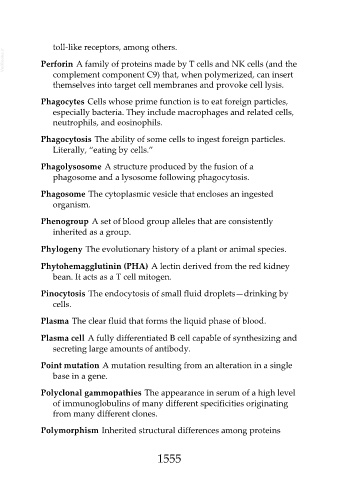Page 1555 - Veterinary Immunology, 10th Edition
P. 1555
toll-like receptors, among others.
VetBooks.ir Perforin A family of proteins made by T cells and NK cells (and the
complement component C9) that, when polymerized, can insert
themselves into target cell membranes and provoke cell lysis.
Phagocytes Cells whose prime function is to eat foreign particles,
especially bacteria. They include macrophages and related cells,
neutrophils, and eosinophils.
Phagocytosis The ability of some cells to ingest foreign particles.
Literally, “eating by cells.”
Phagolysosome A structure produced by the fusion of a
phagosome and a lysosome following phagocytosis.
Phagosome The cytoplasmic vesicle that encloses an ingested
organism.
Phenogroup A set of blood group alleles that are consistently
inherited as a group.
Phylogeny The evolutionary history of a plant or animal species.
Phytohemagglutinin (PHA) A lectin derived from the red kidney
bean. It acts as a T cell mitogen.
Pinocytosis The endocytosis of small fluid droplets—drinking by
cells.
Plasma The clear fluid that forms the liquid phase of blood.
Plasma cell A fully differentiated B cell capable of synthesizing and
secreting large amounts of antibody.
Point mutation A mutation resulting from an alteration in a single
base in a gene.
Polyclonal gammopathies The appearance in serum of a high level
of immunoglobulins of many different specificities originating
from many different clones.
Polymorphism Inherited structural differences among proteins
1555

